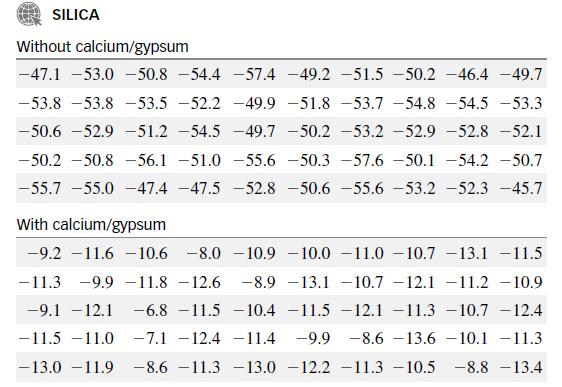Refer to the Minerals Engineering (Vol. 46-47, 2013) study of the impact of calcium and gypsum on
Question:
Refer to the Minerals Engineering (Vol. 46-47, 2013) study of the impact of calcium and gypsum on the flotation properties of silica in water, Exercise 2.23 and 2.34. Recall that one flotation property is zeta potential (measured in mV units). Zeta potential was determined for each of 50 liquid solutions prepared without calcium/gypsum and for 50 liquid solutions prepared with calcium/gypsum.
a. Find the standard deviation for the zeta potential measurements of the liquid solutions prepared without calcium/gypsum. Give an interval that contains most (about 95%) of the zeta potential measurements in this data set.
b. Find the standard deviation for the zeta potential measurements of the liquid solutions prepared with calcium/gypsum. Give an interval that contains most (about 95%) of the zeta potential measurements in this data set.
c. Use the intervals, parts a and b, to make a statement about whether the addition of calcium/gypsum to the liquid solution impacts the flotation property of silica
Data from Exercise 2.23
A high concentration of calcium and gypsum in water can impact the water quality and limit mineral flotation. In Minerals Engineering (Vol. 46-47, 2013), chemical and materials engineers published a study of the impact of calcium and gypsum on the flotation properties of silica in water. Solutions of deionized water were prepared both with and without calcium/gypsum, and the level of flotation of silica in the solution was measured using a variable called zeta potential (measured in millivolts, mV). Assume that 50 specimens for each type of liquid solution were prepared and tested for zeta potential. The data (simulated, based on information provided in the journal article) are provided in the table and saved in the SILICA data file.

Step by Step Answer:

Statistics For Engineering And The Sciences
ISBN: 9781498728850
6th Edition
Authors: William M. Mendenhall, Terry L. Sincich





